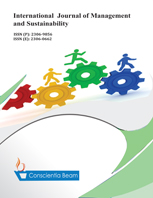The impact of green human resource management practices on employee’s job performance
DOI:
https://doi.org/10.18488/11.v13i3.3828Abstract
The purpose of this study is to examine the impact of Green Human Resource Management (GHRM) on work performance. A quantitative approach was employed to collect numerical data, which underwent statistical analysis. This approach involved the distribution of online questionnaires for convenient feedback collection from respondents. The study tested a set of hypotheses derived from a theoretical model of employee performance using the Statistical Package for the Social Sciences (SPSS). The focus was on understanding the phenomenon of GHRM among employees through quantitative techniques. Empirical results revealed a significant positive correlation between employee job performance and the five dimensions of green human resource management practices. These dimensions include green recruitment and selection, green performance management, green compensation and incentive systems, green training, and green participation. Notably, employee performance exhibited the strongest correlation with green participation, indicating that successful strategies aligning employee involvements with environmental sustainability goals enhance overall work performance. The findings demonstrate that the adoption of green HRM practices can positively impact workers' productivity. The study emphasizes the importance of prioritizing green HRM practices in businesses. The results suggest that integrating these practices can enhance employee engagement, job satisfaction, and motivation, ultimately contributing to improved overall performance. The article outlines the core components of GHRM and elucidates how each component can positively influence productivity in the workplace. Organizations are encouraged to consider and implement these practices to realize the associated benefits.

